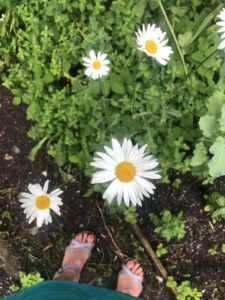Working group excursion: Guided tour through the permaculture garden of Café Botanico Berlin-Neukölln.
- June 2021 from Verena Grewenig

When permaculture gardener and Botanico founder Martin Höfft entered an overgrown allotment in Neukölln in 2012, he had literally found the breeding ground for his nascent Café Botanico. On 1000sqm, old vegetables, fruit and wild plants are now cultivated there in a near-natural way, following the permaculture model. It is the only certified organic forest garden of this size in the inner city area of Berlin.
The treasures from the garden are used fresh in the Botanico kitchen: fruits and vegetables according to season, the aromatic wild herbs even almost all year round. The farm manages without subsidies, grants or bank loans and is financed solely by the sale of produce by the café-restaurant.
A permaculture garden is an ecosystem that is “in operation” all year round and for as many years as possible. Cultivated plants are not immediately removed after harvesting or replaced by new ones. The goal is a habitat that regulates itself as much as possible with the given resources and minimal intervention and maintains a sustainable balance. The space between the individual plantings should be covered with intercrops, weeds or biomass (a mulch cover of dead plant material) and thus protected as much as possible throughout the year. The soil is tilled only superficially and, if possible, not dug up. Some crops remain after harvest and continue to reproduce by root runners or self-seeding. Plucked weeds remain in the bed so that the rotting biomass can enrich the soil.
Fertilizing is done with compost and plant yuks made from stinging nettle, comfrey, cabbage leaves, goutweed, horsetail and other plant debris. Chemical pesticides, even those approved for organic cultivation, are not used. Due to the mixed culture, pests and diseases occur only on individual plants and usually do not cause major damage. In addition, numerous natural enemies of feeding pests live in the natural garden. Spraying the leaves with plant dips can also strengthen plant health and thus the natural defenses of the plants.


Aromatic wild herbs and medicinal plants growing in the Botanico Garden include:
Anise Scented Nettle | Agastache foeniculum | Native American forage and medicinal plant.
Bergamot mint | Mentha x piperita var. citrata ‘Bergamotte’ | peppermint variety with bergamot aroma
Berglauch | Allium senescens | Rare native wild perennial, also as an ornamental plant
Blood sorrel | Rumex sanguineus var. sanguineus | cultivated form of the native wood sorrel
Borage | Borago officinalis | widespread medicinal and cottage garden plant
Brown mustard | Brassica juncea | Varied mustard species from Asia, here Sheurinfong “Green in the Snow
Scented calfweed | Chaerophyllum aromaticum | Rare native wild perennial
Winter cress | Barbarea vulgaris | Native wild herb with cress-like taste
Chervil | Anthriscus cerefolium | Popular native seasoning herb
Spring barbarea | Barbarea verna | Native wild herb with cress-like taste
Garden cress | Lepidium sativum | Wild plant from Western Asia
Evening primrose | Oenothera biennis | Indian medicinal plant, naturalized in Europe
Fennel | Foeniculum vulgare/dulce | Ancient, originally Mediterranean cultivated plant
Goutweed | Aegopodium podagraria | Native medicinal plant and notorious “weed
Groundsel | Glechoma hederacea | Ancient European medicinal and magic plant
Indian nettle | Monarda didyma | Indian medicinal plant with many cultivated forms
Edge leek | Allium angulosum | Old, native seasoning plant
Nasturtium | Tropaeolum majus, | Originally from South America, not related to cress: voted medicinal plant of the year in 2013
Spearmint | Mentha spicata | Popular medicinal and aromatic plant with many varieties
Leek hellebore | Thlaspi alliaceum | Very rare wild plant
Dandelion | Taraxacum officinale | Common native wild plant
Horseradish | Armoracia rusticana | Ancient very healthy medicinal and vegetable plant
Clary sage | Salvia sclarea | European-pre-Asian medicinal and spice plant
Paracress | Acmella oleracea | Spice plant from Brazil
Pepperweed | Lepidium latifolium | Native wild herb
Peppermint | Mentha × piperita | Popular medicinal and aromatic plant with many varieties
Calendula officinalis | Traditional ornamental and medicinal plant in cottage gardens
Chive | Allium tuberosum | Wild plant from China, now cultivated worldwide
Celery | Apium graveolens | Worldwide used medicinal and vegetable plant
Mustard seed | Eruca sativa | Ol
Siberian tellweed | Claytonia sibirica | Perennial relative of winter purslane
Ribwort | Plantago lanceolata | Worldwide wild plant, tastes like fresh mushrooms
Sweetthistle | Myrrhis odorata | Native aromatic and spice plant
Turkish dragonhead | Dracocephalum moldavica | Medicinal plant with lemon fragrance
Venus ridge | Scandix pecten-veneris | Wild plant, now almost extinct in Germany due to modern agriculture
Wasabi | Wasabia japonica, Japanese horseradish | hotter than European horseradish
Water mint | Mentha aquatica, | Native wild perennial; sacred herb of the Druids
Meadow Sorrel | Rumex acetosa | Native wild and cultivated herb
Wild mallow | Malva sylvestris | Wild plant with countless cultivated forms
Wild carrot | Daucus carota | Wild form of the garden carrot with “mock insect” on the flower – used in ancient times as a contreceptive, among other things
Wild rocket | Diplotaxis tenuifolia | Perennial wild form of rocket with yellow flowers
Lemon balm | Melissa officinalis, lemon balm | Medicinal plant from the eastern Mediterranean region
During our 90-minute tour of the garden, we were able to taste many of the above herbs and plants and were surprised and delighted by the sometimes unusual, often unknown and strong aromas. Afterwards, we were able to taste many of the different fresh herb dishes at a joint dinner on the garden terrace in the café at a high summer temperature of 30 degrees. Brilliant!
23.06.2021
Julia Falkenstein
AK leadership Berlin




No Comments